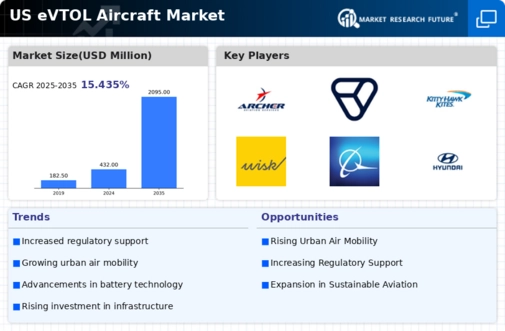Rising Demand for Urban Air Mobility
The increasing congestion in urban areas has led to a rising demand for innovative transportation solutions, particularly in the evtol aircraft market. As cities expand and populations grow, traditional ground transportation systems struggle to keep pace. The evtol aircraft market appears poised to address these challenges by offering efficient, aerial alternatives that can significantly reduce travel times. According to recent estimates, the urban air mobility sector could reach a valuation of $1 trillion by 2040, indicating a robust growth trajectory. This demand is further fueled by the need for sustainable transport options, as urban planners and policymakers seek to minimize carbon footprints. The evtol aircraft market is thus likely to benefit from this shift towards aerial mobility, as it aligns with broader trends in urban planning and environmental sustainability.
Increased Investment from Private Sector
The influx of private sector investment is a key driver for the evtol aircraft market. Venture capital firms and private equity investors are increasingly recognizing the potential of urban air mobility and are directing substantial funds into startups and established companies within the evtol aircraft market. This trend is indicative of a broader shift towards innovative transportation solutions, with investments reaching billions of dollars in recent years. The financial backing from the private sector not only accelerates technological advancements but also enhances competition within the market. As companies strive to differentiate their offerings, consumers may benefit from improved services and lower costs. This dynamic investment landscape is likely to propel the evtol aircraft market forward, fostering innovation and expanding the range of available options for urban air mobility.
Government Support and Funding Initiatives
Government support and funding initiatives are crucial drivers for the growth of the evtol aircraft market. Federal and state governments are increasingly recognizing the potential of urban air mobility and are allocating resources to support research, development, and infrastructure. For example, the Federal Aviation Administration (FAA) has established programs to facilitate the safe integration of evtol aircraft into the national airspace system. Additionally, various grants and funding opportunities are available for companies developing innovative technologies in this sector. The evtol aircraft market is likely to benefit from these initiatives, as they not only provide financial backing but also create a regulatory framework that encourages innovation and collaboration among stakeholders. This supportive environment is essential for accelerating the commercialization of evtol aircraft.
Technological Innovations in Aircraft Design
Technological advancements in aircraft design are playing a pivotal role in shaping the evtol aircraft market. Innovations such as electric propulsion systems, advanced materials, and autonomous flight capabilities are enhancing the performance and safety of these aircraft. For instance, the integration of lightweight composite materials can improve energy efficiency, which is crucial for the viability of electric vertical takeoff and landing vehicles. The evtol aircraft market is witnessing significant investments in research and development, with projections indicating that the market could grow at a CAGR of over 20% through the next decade. These technological innovations not only enhance operational efficiency but also contribute to the overall appeal of evtol aircraft as a viable transportation solution in urban environments.
Environmental Sustainability and Emission Reduction
The growing emphasis on environmental sustainability is significantly influencing the evtol aircraft market. As concerns about climate change and air pollution intensify, there is a pressing need for cleaner transportation alternatives. The evtol aircraft market is well-positioned to address these concerns, as many of these vehicles are designed to operate on electric power, thereby reducing greenhouse gas emissions. Studies suggest that transitioning to electric aviation could lead to a reduction of up to 50% in emissions compared to traditional aircraft. This potential for emission reduction aligns with broader governmental and societal goals for sustainability, making evtol aircraft an attractive option for urban transportation. As public awareness of environmental issues increases, the demand for sustainable transport solutions is likely to drive growth in the evtol aircraft market.
























Leave a Comment